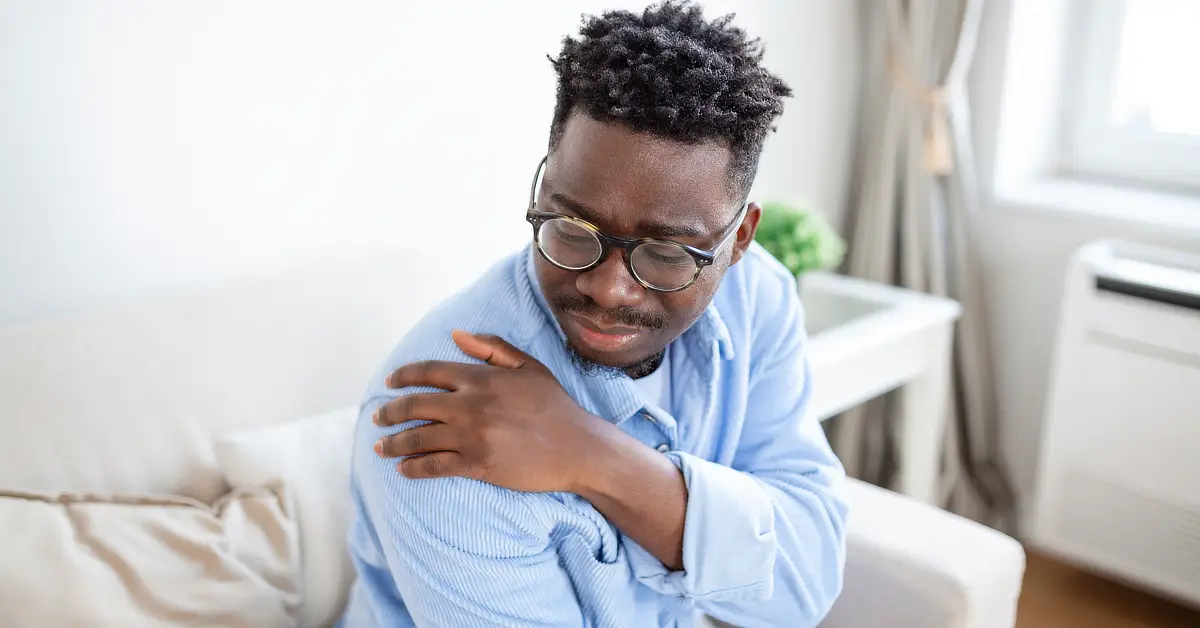Arthritis is a painful condition. The main symptoms of arthritis are pain or stiffness in one or more body joints. The pain may be mild or severe. It may come and go but often becomes worse over time.
Anyone of any age can suffer from arthritis. However, it is commonest among women and occurs more frequently as people grow older.
There are more than 100 types of arthritis. The most common are osteoarthritis and rheumatoid arthritis.
Osteoarthritis occurs when the cartilage between bones, which prevents the bones rubbing against each other when joints move, wears away. Bone therefore rubs against bone causing pain, stiffness and sometimes swelling. Over time the joint can lose its strength. The pain may become chronic.
Risk factors for osteoarthritis include being overweight, family history, age and previous injury. The likelihood of developing osteoarthritis can be minimised by being active, maintaining a healthy weight and avoiding injury and repetitive movements.
When the symptoms are mild or moderate, they can be managed by balancing activity with rest, applying hot or cold compresses, regular physical activity, maintaining a healthy weight, exercises to strengthen the muscles around the joint, taking over-the-counter pain killers or anti-inflammatory medicines and by avoiding excessive repetitive movements involving the joint concerned.
If the symptoms become so severe that they cause limited mobility, surgery may be necessary to replace a joint with an artificial one.
Rheumatoid arthritis is an autoimmune disorder that attacks the synovium, which is the lining of membranes that surrounds joints. The body’s immune system generates internal inflammation to rid the body of infection and fight disease. However, the system can mistakenly attack joints with uncontrolled inflammation.
When this happens it can cause joint erosion. The inflammation thickens the synovium, which can eventually destroy the cartilage and bone within the joint. It can also cause damage to internal organs, including the lungs, heart and kidneys, and other parts of the body, including the eyes, skin, blood vessels, bone marrow and nerve tissue.
Symptoms of rheumatoid arthritis include tender, warm, swollen joints and joint stiffness that is usually worse in the morning and after inactivity. Rheumatoid arthritis may also cause fatigue, fever and weight loss.
Early rheumatoid arthritis tends to affect smaller joints first, particularly finger and toe joints. The severity of symptoms may vary and may come and go. Periods of increased disease activity, referred to as flares, may alternate with periods of remission, when swelling and pain may fade or even disappear.
Over time rheumatoid arthritis can cause joints to become deformed or shift out of place. The tendons and ligaments that hold the joint together become weaker and stretch. Gradually the joint may lose its shape and alignment.
Risk factors for rheumatoid arthritis include being female, being aged between 40 and 60, having a family member who has rheumatoid arthritis, smoking, obesity and exposure to asbestos or silica.
Uric acid crystals, infections or underlying disease, such as psoriasis or lupus, can cause other types of arthritis, including gout.
Severe arthritis can make daily tasks difficult, particularly if it affects the hands or arms. Arthritis of weight-bearing joints can make walking or sitting up straight difficult or uncomfortable. Some joints may become twisted and deformed.
It is advisable to visit your doctor or clinic if you have persistent discomfort and swelling in any of your joints.
The doctor will check your joints for swelling, redness and warmth and check how well you can move your joints. Rheumatoid arthritis is difficult to detect in the early stages as symptoms may be the same as those for other diseases.
Depending on the type of arthritis suspected, the doctor may suggest blood tests or urine tests. Fluid may also be taken from the affected joint. X-rays, MRI (magnetic resonance imaging) and ultrasound tests may also be requested.
Arthritis treatment focuses on relieving symptoms and improving joint function. Where medication is concerned, this depends on the type of arthritis,
Analgesics may be used to relieve pain but they do nothing for inflammation. Non-steroidal anti-inflammatory drugs, such as ibuprofen, reduce both pain and inflammation. Steroids, such as prednisone, reduce inflammation and pain and slow joint damage.
Disease modifying anti-rheumatic drugs slow the progression of rheumatoid arthritis and save the joints and other tissues from permanent damage. There are also biologic agents that can target parts of the immune system that trigger inflammation that causes joint and tissue damage.
All of these medications, like almost all medication, have adverse side effects.
Physiotherapy may be helpful for some types of arthritis. A physiotherapist or occupational therapist can teach you exercises to keep your joints flexible.
Exercise is crucial for anyone with arthritis. It increases strength and flexibility, reduces joint pain and helps combat fatigue. It does not have to be vigorous. Even moderate exercise can ease the pain and help maintain a healthy weight. Walking or swimming are good forms of exercise.
Exercise can help improve the range of motion of the affected limb and strengthen the muscles surrounding the joints. It helps maintain bone strength, gives you more energy, makes it easier to sleep at night and helps control your weight.
Some might fear that exercise would aggravate their joint pain and stiffness It does not. Lack of exercise can make your joints even more painful and stiff.
Keeping your muscles and surrounding tissue strong is crucial to maintaining support for your bones. Not exercising weakens the supporting muscles, creating more stress on your joints.
It is wise to discuss with your doctor or physiotherapist the most appropriate exercise and how regular it should be.
There are various assistive devices that can make some activities easier and avoid stressing your joints. An occupational therapist can not only recommend such devices but suggest alternative ways of doing things that are easier on the affected joints.
If medications fail to prevent or slow joint damage, surgery could be considered to repair damaged joints and restore the ability to use them.






